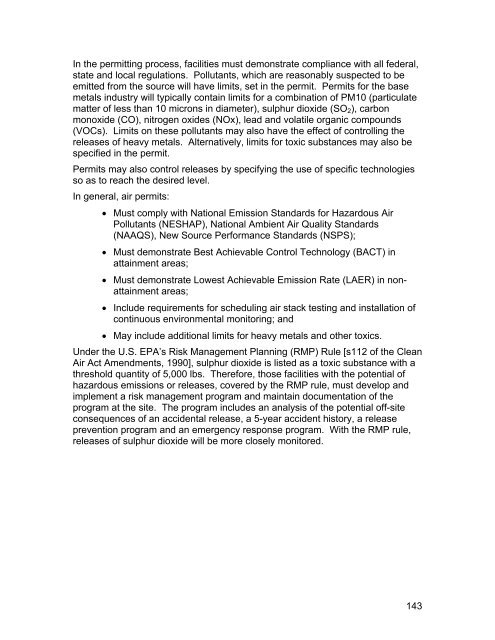(MERAF) for the Base Metals Smelting Sector - CCME
(MERAF) for the Base Metals Smelting Sector - CCME
(MERAF) for the Base Metals Smelting Sector - CCME
Create successful ePaper yourself
Turn your PDF publications into a flip-book with our unique Google optimized e-Paper software.
In <strong>the</strong> permitting process, facilities must demonstrate compliance with all federal,<br />
state and local regulations. Pollutants, which are reasonably suspected to be<br />
emitted from <strong>the</strong> source will have limits, set in <strong>the</strong> permit. Permits <strong>for</strong> <strong>the</strong> base<br />
metals industry will typically contain limits <strong>for</strong> a combination of PM10 (particulate<br />
matter of less than 10 microns in diameter), sulphur dioxide (SO 2 ), carbon<br />
monoxide (CO), nitrogen oxides (NOx), lead and volatile organic compounds<br />
(VOCs). Limits on <strong>the</strong>se pollutants may also have <strong>the</strong> effect of controlling <strong>the</strong><br />
releases of heavy metals. Alternatively, limits <strong>for</strong> toxic substances may also be<br />
specified in <strong>the</strong> permit.<br />
Permits may also control releases by specifying <strong>the</strong> use of specific technologies<br />
so as to reach <strong>the</strong> desired level.<br />
In general, air permits:<br />
• Must comply with National Emission Standards <strong>for</strong> Hazardous Air<br />
Pollutants (NESHAP), National Ambient Air Quality Standards<br />
(NAAQS), New Source Per<strong>for</strong>mance Standards (NSPS);<br />
• Must demonstrate Best Achievable Control Technology (BACT) in<br />
attainment areas;<br />
• Must demonstrate Lowest Achievable Emission Rate (LAER) in nonattainment<br />
areas;<br />
• Include requirements <strong>for</strong> scheduling air stack testing and installation of<br />
continuous environmental monitoring; and<br />
• May include additional limits <strong>for</strong> heavy metals and o<strong>the</strong>r toxics.<br />
Under <strong>the</strong> U.S. EPA’s Risk Management Planning (RMP) Rule [s112 of <strong>the</strong> Clean<br />
Air Act Amendments, 1990], sulphur dioxide is listed as a toxic substance with a<br />
threshold quantity of 5,000 lbs. There<strong>for</strong>e, those facilities with <strong>the</strong> potential of<br />
hazardous emissions or releases, covered by <strong>the</strong> RMP rule, must develop and<br />
implement a risk management program and maintain documentation of <strong>the</strong><br />
program at <strong>the</strong> site. The program includes an analysis of <strong>the</strong> potential off-site<br />
consequences of an accidental release, a 5-year accident history, a release<br />
prevention program and an emergency response program. With <strong>the</strong> RMP rule,<br />
releases of sulphur dioxide will be more closely monitored.<br />
143
















